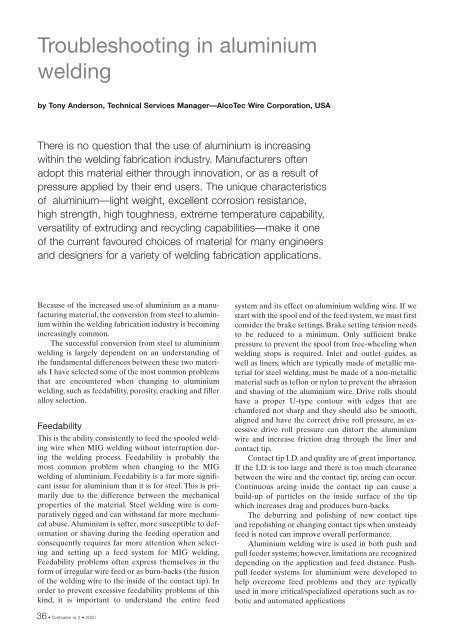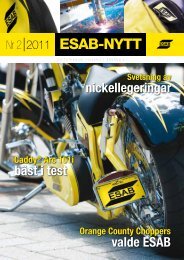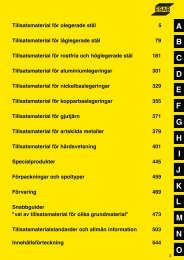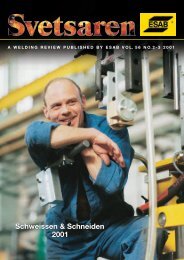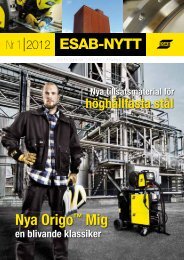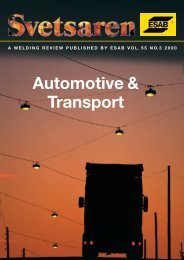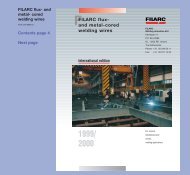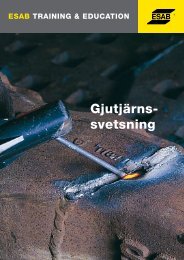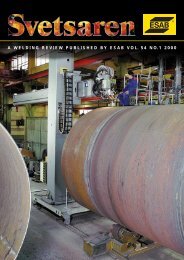Svetsaren nr 2. 2000 - Esab
Svetsaren nr 2. 2000 - Esab
Svetsaren nr 2. 2000 - Esab
- No tags were found...
You also want an ePaper? Increase the reach of your titles
YUMPU automatically turns print PDFs into web optimized ePapers that Google loves.
Troubleshooting in aluminiumweldingby Tony Anderson, Technical Services Manager—AlcoTec Wire Corporation, USAThere is no question that the use of aluminium is increasingwithin the welding fabrication industry. Manufacturers oftenadopt this material either through innovation, or as a result ofpressure applied by their end users. The unique characteristicsof aluminium—light weight, excellent corrosion resistance,high strength, high toughness, extreme temperature capability,versatility of extruding and recycling capabilities—make it oneof the current favoured choices of material for many engineersand designers for a variety of welding fabrication applications.Because of the increased use of aluminium as a manufacturingmaterial, the conversion from steel to aluminiumwithin the welding fabrication industry is becomingincreasingly common.The successful conversion from steel to aluminiumwelding is largely dependent on an understanding ofthe fundamental differences between these two materials.I have selected some of the most common problemsthat are encountered when changing to aluminiumwelding, such as feedability, porosity, cracking and filleralloy selection.FeedabilityThis is the ability consistently to feed the spooled weldingwire when MIG welding without interruption duringthe welding process. Feedability is probably themost common problem when changing to the MIGwelding of aluminium. Feedability is a far more significantissue for aluminium than it is for steel. This is primarilydue to the difference between the mechanicalproperties of the material. Steel welding wire is comparativelyrigged and can withstand far more mechanicalabuse. Aluminium is softer, more susceptible to deformationor shaving during the feeding operation andconsequently requires far more attention when selectingand setting up a feed system for MIG welding.Feedability problems often express themselves in theform of irregular wire feed or as burn-backs (the fusionof the welding wire to the inside of the contact tip). Inorder to prevent excessive feedability problems of thiskind, it is important to understand the entire feedsystem and its effect on aluminium welding wire. If westart with the spool end of the feed system, we must firstconsider the brake settings. Brake setting tension needsto be reduced to a minimum. Only sufficient brakepressure to prevent the spool from free-wheeling whenwelding stops is required. Inlet and outlet guides, aswell as liners, which are typically made of metallic materialfor steel welding, must be made of a non-metallicmaterial such as teflon or nylon to prevent the abrasionand shaving of the aluminium wire. Drive rolls shouldhave a proper U-type contour with edges that arechamfered not sharp and they should also be smooth,aligned and have the correct drive roll pressure, as excessivedrive roll pressure can distort the aluminiumwire and increase friction drag through the liner andcontact tip.Contact tip I.D. and quality are of great importance.If the I.D. is too large and there is too much clearancebetween the wire and the contact tip, arcing can occur.Continuous arcing inside the contact tip can cause abuild-up of particles on the inside surface of the tipwhich increases drag and produces burn-backs.The deburring and polishing of new contact tipsand repolishing or changing contact tips when unsteadyfeed is noted can improve overall performance.Aluminium welding wire is used in both push andpull feeder systems; however, limitations are recognizeddepending on the application and feed distance. Pushpullfeeder systems for aluminium were developed tohelp overcome feed problems and they are typicallyused in more critical/specialized operations such as roboticand automated applications36 • <strong>Svetsaren</strong> <strong>nr</strong> 2 • <strong>2000</strong>


